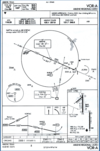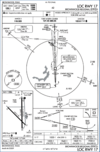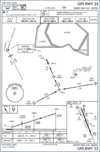Test Gauge Flashcards
(47 cards)
You would get a graphic depiction of the landing environment for a particular airfield _____.
from the airport sketch on an instrument approach plate for that airfield.–
If the departure end of the runway is in sight and you are executing climbout instructions, delay any turns until past the departure end of the runway and _____ feet AGL.
d. 400–
- Use ______ when being vectored to final for a no-gyro PAR.
d. standard rate turns—
- When will you begin your descent to the MDA on the VOR A approach to Abilene Regional?

d. At BURGE–
- As you approach the holding or clearance limit, you should begin slowing to holding airspeed within ______ minute(s) out.
b. 3—
- What type of instrument departure includes specific published routes and altitude restrictions?
a. Departure Procedure (DP)
- You receive these holding instructions from the controller “Hold north of the XYZ 360 degree radial, 20 NM fix, 10 mile legs.” Based on the instructions, you will make _____ turns in the holding pattern.
d. right
- When performing an ITO during cloudy weather conditions, you transition to a completely instrument based cross-check ______.
d. will depend on the rate that outside references are lost
- Which of the following depictions shows a standard holding pattern?

d. D
- You are approaching the IAF for a high altitude teardrop approach at the published IAF altitude. You may begin your descent from this altitude ______.
d. when you are past the IAF and established on a parallel or intercept heading to the outbound approach course
- You can descend from the MDA when _____.
b. you can maintain visual contact with the landing environment
- The heavy black line with an arrowhead showing the intended aircraft ground track on this approach depicts a ______ approach.

c. procedure track
- Instrument Takeoff (ITO) procedures _____.
d. are for takeoffs during reduced or restricted visibility conditions–
- When receiving a new in-flight clearance, you must read back all the following the controller gives you, EXCEPT ______ .
a. weather information
- When transitioning to visual references during an actual instrument final approach, a good technique is to start peeking outside ______.
c. nearing the reported weather ceiling
- If flying an ILS precision approach, the missed approach point occurs _____.
b. when you reach the published decision height (DH)
- The holding pattern (in lieu of a procedure turn) is depicted by _____.
c. a holding pattern printed with a bold, black line
- In the approach active mode, as you approach the FAF on a GPS approach, its ______.
d. waypoint identifier flashes on the GPS display
- When can you descend out of 3500 feet while flying the HI ILS RWY 29R at Fresno Yosemite INTL?

d. At SANGO
- PAR DH is determined by _____.
a. aircraft’s barometric altimeter reading b. controller states “At Decision Height” whichever occurs first
- In the T-6A, you can hold over all of the following EXCEPT _____. a. GPS waypoint b. TACAN c. intersection d. VOR/NDB
TACAN
- Instrument departures are designed to _____.
a. safely take the aircraft from takeoff to the next phase of flight (normally an enroute structure to an operating area, the airways, or back to the terminal area)
- Select the true statement. a. If a barb is not depicted, you have the option of flying the procedure turn. b. If the procedure specifies NoPT, you will not fly a procedure turn. c. If you are established in a holding pattern that is aligned with the procedure turn course, you must fly the procedure turn. d. If you are on radar vectors to final, you may fly the procedure turn.
b. If the procedure specifies NoPT, you will not fly a procedure turn.
- This approach is called a ______.

d. Procedure turn







